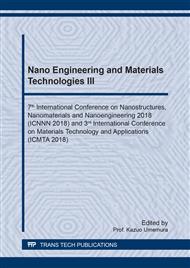p.61
p.66
p.71
p.77
p.82
p.91
p.96
p.103
p.109
Silica Nanoparticle Synthesis and Multi-Method Characterisation
Abstract:
The information provided by different characterisation methods when measuring particle size varies depending on the chosen technique and analytical approach (e.g. light scattering, transmission electron microscopy, spectroscopy, x-ray scattering). This in turn has an impact on the accuracy of the results as well as comparability between methods and overall confidence on the analyses. The present study used a common sol-gel reaction to synthesise amorphous silica nanoparticles (aSiNPs) and characterised the product purity and homogeneity. The reaction involved hydrolysis and condensation of tetraethyl orthosilicate (TEOS) in the presence of lysine, which acted as catalyst for the silica production and also as a capping agent for particle size control in a suspension kept at pH 8-10. According to DLS data, the stock suspension was stable for at least 6 months in Milli Q water without surfactant when kept at 4°C. This study focused on multi-method size and shape characterisation of the aSiNPs, involving the following techniques: DLS, TEM, FTIR, STEM and SAXS. These techniques provided information on hydrodynamic diameter, core particle dimensions, sphere equivalent size, and radius of gyration. Our results show two particle populations, one around 2 nm and the other around 7 nm in diameter. Notably, these two populations are not resolved (i.e. “visible”) by all methods used.
Info:
Periodical:
Pages:
82-90
Citation:
Online since:
March 2019
Price:
Сopyright:
© 2019 Trans Tech Publications Ltd. All Rights Reserved
Share:
Citation:


